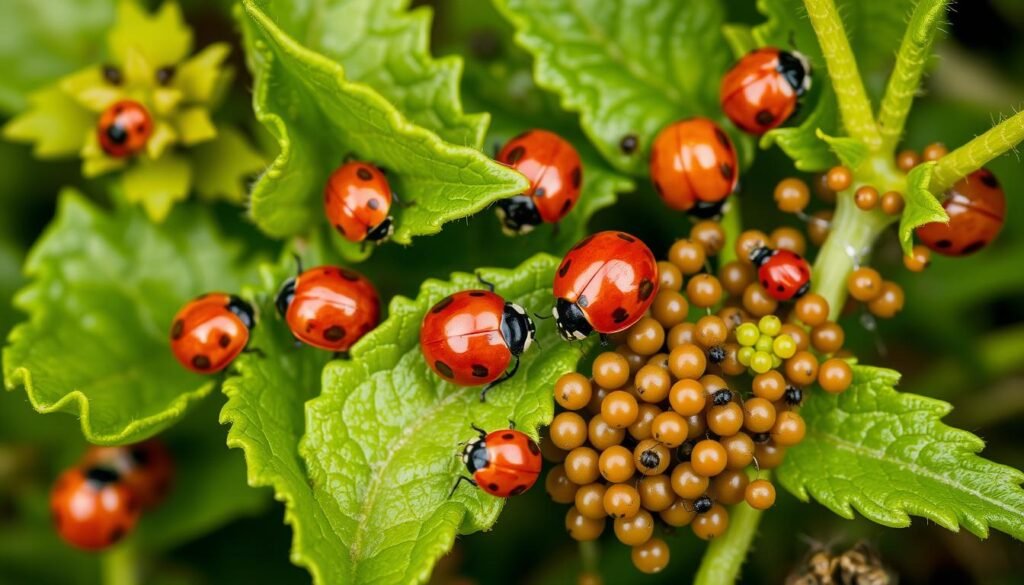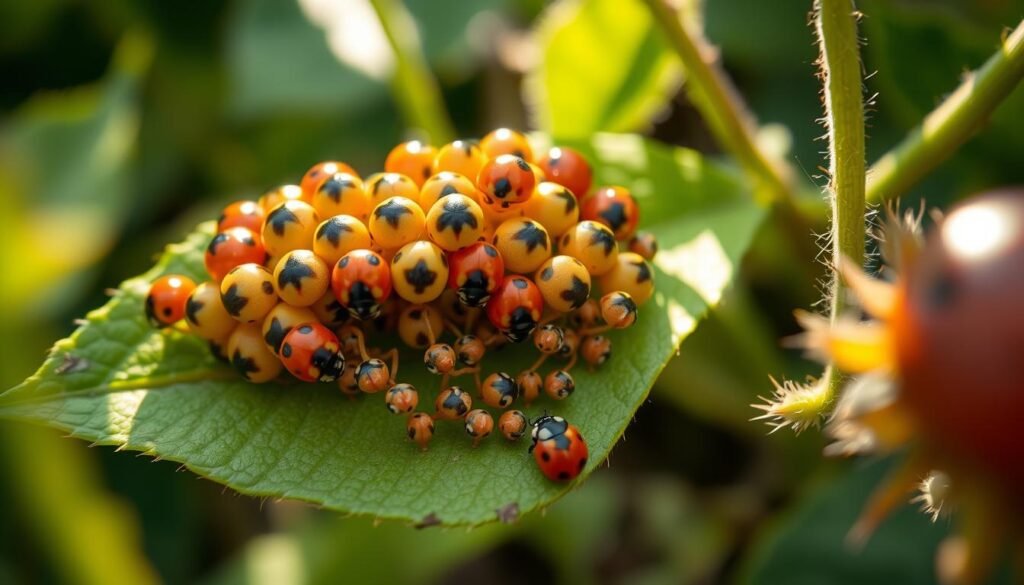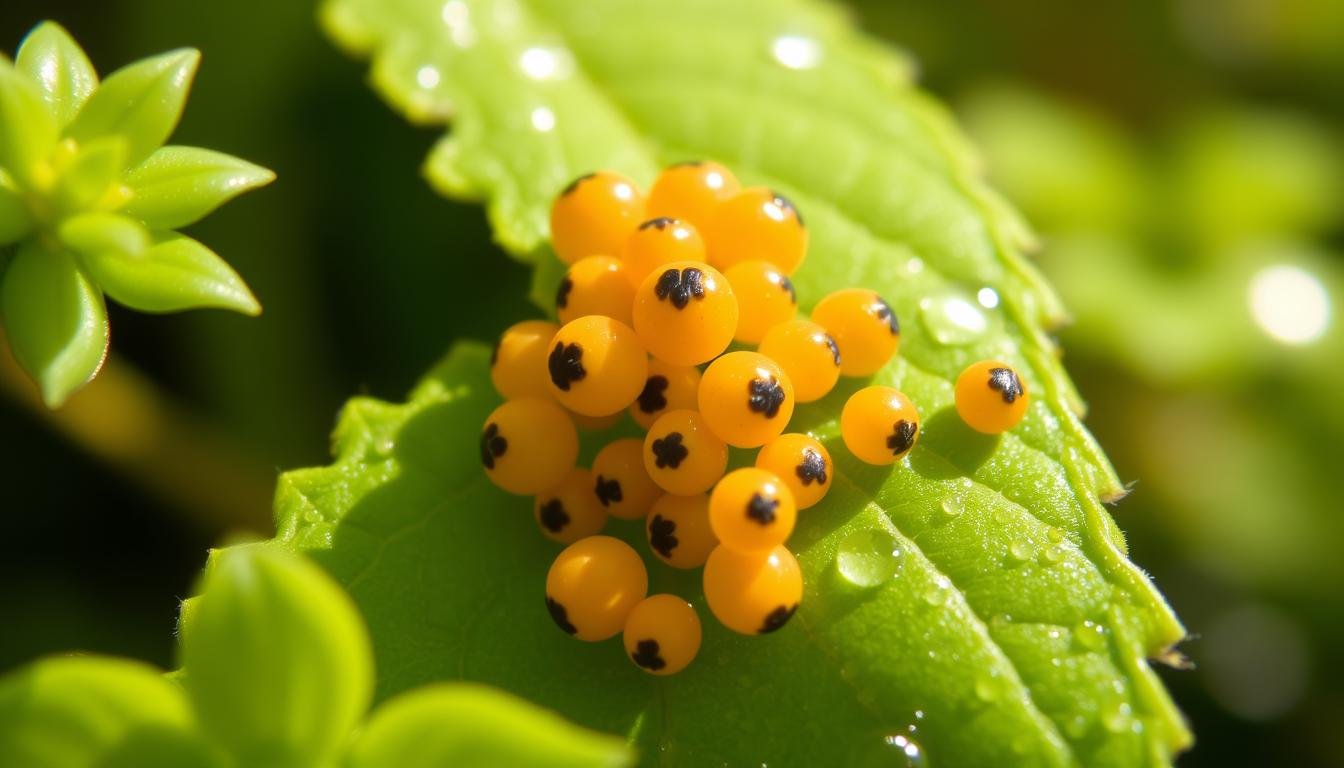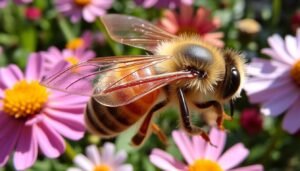Ladybug eggs are small and oval, about 1 millimeter big. They often stick together for safety.
As I walk through my garden, I love the colors and smells. Ladybugs are a big part of this beauty. They help by eating pests. But first, let’s look at their eggs.
Key Takeaways
- Ladybugs can lay between 10 and 50 eggs in a single cluster.
- Female ladybugs can produce up to 1,000 eggs during spring and early summer.
- Eggs can vary in color, with shades from pale yellow to bright orange-red.
- Ladybug eggs are approximately 1 millimeter tall and can be taller than they are wide.
- Ladybug larvae may consume dozens of aphids each day, helping control garden pests.
- Hatching times for ladybug eggs can range from 2 to 10 days, influenced by temperature.
Table of Contents
Introduction to Ladybug Eggs
Ladybugs, also known as lady beetles, are interesting in the ecosystem. Their ladybug eggs description is fascinating. These eggs are laid in groups of 5 to 30, starting the life cycle of these helpful insects. The ladybug egg importance is huge, as they help control garden pests like aphids.
The eggs are yellow-orange, making them easy to see on plants. By watching these clusters, gardeners can learn about ladybug life. This includes four stages: egg, larva, pupa, and adult. Knowing these stages helps gardeners support ladybugs.
Understanding ladybug reproduction is key to their health. By learning about the ladybug eggs description, gardeners can boost biodiversity. As these eggs grow, they help nature’s cycles, leading to healthy gardens with less chemical use.
| Life Cycle Stage | Duration | Description |
|---|---|---|
| Egg | 3-7 days | Bright yellow-orange clusters, laid on the underside of leaves |
| Larva | 2-4 weeks | Distinct coloration, elongated shape, voracious predators |
| Pupa | 1-2 weeks | Non-feeding stage, transformation into adult |
| Adult | 2-3 months | Bright colors, established pests control agents |
Understanding Ladybug Life Cycle
The ladybug life cycle is full of interesting stages. It shows how complete metamorphosis works. Each stage is vital for garden health. The journey starts when the female lays eggs.
The Stages of Complete Metamorphosis
The complete metamorphosis of ladybugs has four stages: egg, larvae, pupae, and adult. A female ladybug can lay 20 to 1,000 eggs. These eggs are 1 to 2 millimeters long and hatch in 3 to 10 days.
After hatching, the larvae look for food. They eat a lot of aphids, sometimes more than their own weight. The larval stage lasts 2 to 4 weeks. They molt four times before becoming pupae.
The pupal stage lasts about seven to fifteen days. During this time, they change a lot. The whole ladybug development takes about six weeks, depending on the environment.
Importance of Ladybug Eggs in the Cycle
Ladybug eggs in garden environments are very important. They help the species survive and provide food for new larvae. This balance is key for controlling pests.
Ladybug larvae eat a lot of aphids, which are common pests. The benefits of ladybug life cycle help plants stay healthy. Each stage helps reduce pest numbers.
What Do Ladybugs Eggs Look Like
It’s important to know what ladybug eggs look like. This knowledge helps gardeners and bug lovers understand their ecosystems better. Knowing what ladybug eggs look like is key. It makes gardening better and connects us to nature.
Physical Characteristics of Ladybug Eggs
Ladybug eggs are easy to spot because of their shape and color. They are tall and oval, and their colors range from yellow to orange-red. This makes them stand out against green leaves.
Most of these eggs are clear, so you can see the baby inside. This helps you find them in your garden.
Variations Across Different Species
Different ladybug species have different egg looks. For example, the Seven-spotted ladybug eggs are easy to spot in clusters. But other species might lay eggs in different ways.
Some eggs might have special patterns or sizes. Knowing these differences helps you identify ladybug eggs better. This knowledge helps make your garden a better place for ladybugs.
If you’re interested in gardening, learning about ladybugs is great. You can also learn about the best soil for plants and caring for tropical plants like birds of paradise. For more info, check out this link.
Ladybug Egg Appearance and Color
Ladybug eggs are small and come in different colors. They are often found in gardens. Knowing these ladybug egg colors helps gardeners protect these important insects.
Common Colors of Ladybug Eggs
Ladybug eggs show a variety of bright colors. The most common colors are:
- Pale Yellow
- Almost White
- Vibrant Orange-Red
Knowing these color differences in ladybug eggs makes ladybug egg identification easier. Each color can tell you which ladybug species is in your garden. This helps you care for them better.
Identifying Ladybug Eggs by Color
Identifying ladybug eggs by color is key to good garden care. The color of the eggs often shows which ladybug species is there. This knowledge helps keep the eggs safe and their homes good.
Ladybug Egg Size and Shape
Learning about ladybug egg size and shape is key for anyone who loves these bugs. Ladybug eggs are usually 1 to 2 millimeters long. They are small and hard to see, blending in with plant leaves.
Knowing about ladybug egg sizes helps me find them in the garden. It’s a fun challenge.
Typical Dimensions of Ladybug Eggs
Ladybug eggs are often found in groups of 10 to 50. The number depends on the ladybug species. Some lay fewer eggs, while others can lay hundreds.
Female ladybugs can carry fertilized eggs inside for weeks. This makes spotting new eggs tricky.
How Shape Can Help in Identification
The shape of ladybug eggs is key to telling them apart from other insects. They are long and oval, taller than wide. This shape helps identify them, especially in groups on leaves.
When looking for ladybug eggs in the garden, remember this unique shape. It makes finding them more exciting.
Ladybug Egg Clusters and Placement
Finding ladybug eggs in your garden is exciting. It’s important to know where to look. Ladybug egg clusters are usually found on the undersides of leaves or on flowerpots. These spots are great because they have lots of aphids, which ladybugs love.
Where to Find Ladybug Egg Clusters
Spotting ladybug eggs takes patience and a sharp eye. Look in places where ladybugs are often seen. Some good spots include:
- Undersides of leaves, where eggs are safe from predators.
- Areas with aphids, since ladybugs like these spots.
- Young plants or flowers that offer shelter and food.
- At garden edges, where ladybugs might hide.
Characteristics of Egg Clusters
Knowing how to spot egg clusters helps you understand ladybugs better. Here are some key things to look for:
- They form tight groups, with 5 to 30 eggs.
- Clusters look like beads, making them easy to spot.
- Eggs are long and oval, and might be covered in a protective layer.
- They are often yellow, which helps you find them.
Looking for these egg clusters is important. They show ladybugs are around and help control pests. The life of ladybugs starts with these small clusters, helping keep gardens balanced.
Identifying Ladybug Eggs in Your Garden
Finding ladybug eggs in your garden is a special joy. It shows you care about keeping your garden balanced. By knowing when and how to look, you can start a fun search for these eggs.
Best Time of Year to Spot Ladybug Eggs
The best time to find ladybug eggs is in spring and early summer. Female ladybugs are very busy laying eggs then. This is when aphids are plentiful, which is great for the eggs and ladybugs.
How to Search for Eggs Effectively
To find ladybug eggs, you need to be careful and look closely. Start by checking the undersides of leaves. Ladybugs like these spots for their eggs. A magnifying glass helps see the eggs’ yellowish-orange color.
Visit these spots often during the egg hatching season. This will help you find these important eggs.
Importance of Ladybug Eggs in Pest Control

Knowing about ladybug eggs is key to a healthy garden. Ladybugs help control pests like aphids, which are common in gardens. Seeing ladybug eggs means more beneficial insects will come, keeping things balanced.
Role of Ladybugs in the Garden Ecosystem
Ladybugs are great at eating pests like aphids, spider mites, and mealybugs. They can eat up to 5,000 aphids in their lifetime. This is very helpful in keeping pest numbers down.
Ladybug larvae start eating aphids soon after they hatch. They eat hundreds of aphids in just 2-3 weeks. This natural way of controlling pests means less need for harmful chemicals.
Benefits of Encouraging Ladybug Breeding
Encouraging ladybugs in my garden has many benefits. Planting flowers like marigolds, fennel, and alyssum attracts them. Adding water sources and ladybug houses helps too.
This approach boosts ladybug numbers and helps control pests without chemicals. I’ve seen fewer pests and healthier plants because of it.
For more tips on attracting ladybugs, check this resource. Using these methods can make your garden better and more effective at controlling pests.
Ladybug Egg Hatching Process
The ladybug egg hatching process is very interesting. It starts quickly and is affected by the environment. Knowing about this helps us understand how ladybugs keep our world balanced.
Timeline from Egg to Larvae
When a female ladybug lays her eggs, they hatch soon after. The time it takes can be from 3 to 10 days. Then, the larvae start their life, eating a lot of food.
One larva can eat more than its own weight in a day. This is how they grow fast.
Conditions Affecting Hatching Success
Many things can affect if ladybug eggs hatch well. Temperature, humidity, and food are key. For example, warm weather makes eggs hatch faster.
Right humidity helps them grow strong. Good conditions mean more ladybugs grow up.
| Stage | Duration | Details |
|---|---|---|
| Egg Incubation | 3 to 10 days | Duration varies with environmental conditions. |
| Larval Stage | 2 to 4 weeks | Larvae consume about 350 to 400 aphids in this period. |
| Pupal Stage | 7 to 15 days | Transformation from larva to adult ladybug. |
Tips for Protecting Ladybug Eggs
To help ladybugs grow, we must protect their eggs well. Making a welcoming home for them is key. The right place helps their eggs and young grow strong.
Creating a Ladybug-Friendly Environment
A good garden draws ladybugs and helps them thrive. Here are tips for a ladybug-friendly garden:
- Plant foods like brassicas and sunflowers to feed ladybugs.
- Use plants for shelter and avoid harmful chemicals.
- Keep a mix of plants to help all insects, not just ladybugs.
- Use natural gardening to keep ladybugs safe.
- Let some aphids stay to feed ladybugs.
Common Threats to Ladybug Eggs
Even with care, ladybug eggs face many dangers. Knowing these threats helps us protect them better.
- Birds and other insects might eat ladybug eggs.
- Pesticides harm ladybug eggs and young.
- Severe weather can hurt new eggs.
- Ants farming aphids can reduce food for ladybugs.
| Threat | Impact on Ladybug Eggs |
|---|---|
| Predators | Can directly consume eggs and larvae. |
| Pesticides | May kill ladybug eggs and disrupt their lifecycle. |
| Environmental Extremes | Extreme temperatures can damage or destroy eggs. |
| Ant Farming | Reduces the availability of aphids, depleting food sources. |
By following these tips and knowing the dangers, we can help ladybugs in our gardens. This supports their growth and survival.
Key Differences Between Ladybug Eggs and Other Insect Eggs
Identifying ladybug eggs can be tricky for gardeners. It’s key to know the differences to manage these helpful bugs well. Understanding their unique traits helps us tell them apart from other insect eggs.
How to Distinguish Ladybug Eggs
To distinguish ladybug eggs, look at a few things. Ladybug eggs are small, round, and often found in groups on leaf undersides. This is different from other insect eggs.
Their color is usually yellow to orange. This color helps us spot them. These features make ladybug eggs stand out from harmful insects like aphids or caterpillars.
Common Misidentifications in the Garden
It’s easy to get confused with other insect eggs in the garden. Gardeners might misidentify ladybug eggs when they see eggs that look similar. For example, aphid eggs can look like ladybug eggs at first.
Knowing the small differences helps me spot ladybug eggs better. This way, I can protect their numbers in my garden.
The Fascination of Observing Ladybug Development

Watching ladybugs grow is truly fascinating. It shows us the amazing stages of their life. I love seeing them change from eggs to cute larvae. It’s a reminder of nature’s beauty and how it helps our world.
My Personal Experience with Ladybugs
My garden is full of ladybugs, and it’s a learning adventure. When I see their eggs in spring, I get excited. Soon, tiny larvae appear, showing how fast they change.
Every week, they grow and change. It’s a chance to learn about ladybugs and share with others. You can find more about this at this link.
Educational Opportunities in the Garden
The garden is a great place to teach kids about ladybugs. I use pictures and coloring sheets to help them learn. Kids aged 3 to 6 can draw what they see.
This way, they learn and have fun. It also teaches them to care for nature.
Conclusion
Ladybug eggs play a key role in our ecosystem. Knowing how they look, how long they take to hatch, and what affects their survival is important. This knowledge helps us garden better.
Female ladybugs can lay dozens to hundreds of eggs. Creating a good home for these insects is key to a balanced garden.
Ladybug eggs are more than just a part of their life cycle. They help control pests like aphids. This is crucial for a healthy garden.
By supporting ladybug breeding, we help our gardens. This makes our gardens full of life and variety.
Watching ladybugs in my garden shows me their beauty and importance. Learning about their eggs helps us protect them. This keeps our gardens healthy.




